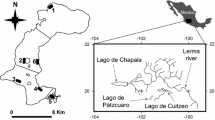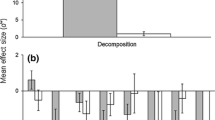Abstract
While it is accepted that invasive species are non-native organisms that become abundant and cause ecological damage in areas where they are introduced, the problem of ‘native invaders,’ native species that become excessively abundant due to anthropogenic impacts, is frequently encountered by ecologists. Often, native and non-native invaders occur in sympatry. Understanding relative severity of their impacts and niches they occupy is needed to inform management actions. Here, we quantify relative impact of native (black bullhead) and non-native (common carp) benthic fish on macrophytes species richness in over 200 lakes in North America. The impact of each species was addressed while accounting for the effects of water clarity, depth, lake area, watershed size, shoreline irregularity, land use by humans, abundance of planktivorous fishes, and ecoregion. Using model selection, we show that both species had negative impact on macrophytes richness, but the impact of carp was approximately two times as strong when adjusted for catch rates. We also conducted a principal component analysis followed by permutation procedures, which showed that carp and bullheads often occurred together in shallow, turbid lakes in watershed dominated by human use. Our findings have implications for lake-restoration efforts via carp or bullhead management.




Similar content being viewed by others
References
Badiou, P. H. J. & L. G. Goldsborough, 2010. Ecological impacts of an exotic benthivorous fish in large experimental wetlands, Delta Marsh, Canada. Wetlands 30(4): 657–667.
Bajer, P. G. & P. W. Sorensen, 2010. Recruitment and abundance of an invasive fish, the common carp, is driven by its propensity to invade and reproduce in basins that experience winter-time hypoxia in interconnected lakes. Biological Invasions 12: 1101–1112.
Bajer, P. G. & P. W. Sorensen, 2015. Effects of common carp on phosphorus concentrations, water clarity, and vegetation density: a whole system experiment in a thermally stratified lake. Hydrobiologia 746: 303–311.
Bajer, P. G., G. Sullivan & P. W. Sorensen, 2009. Effects of a rapidly increasing population of common carp on vegetative cover and waterfowl in a recently restored Midwestern shallow lake. Hydrobiologia 632: 235–245.
Bajer, P. G., T. K. Cross, J. D. Lechelt, C. J. Chizinski, M. J. Weber & P. W. Sorensen, 2015a. Across-ecoregion analysis suggests a hierarchy of ecological filters that regulate recruitment of a globally invasive fish. Diversity and Distributions 21: 500–510.
Bajer, P. G., J. E. Parker, T. K. Cross, P. A. Venturelli & P. W. Sorensen, 2015b. Partial migration to seasonally-unstable habitat facilitates biological invasions in a predator-dominated system. Oikos 124: 1520–1526.
Bajer, P. G., M. W. Beck, T. K. Cross, J. D. Koch, W. M. Bartodziej & P. W. Sorensen, 2016. Biological invasion by a benthivorous fish reduced the cover and species richness of aquatic plants in most lakes of a large North American ecoregion. Global Change Biology 22: 3937–3947.
Barton, K., 2015. MuMIn: Multi-model inference. R package version 1.15.1. [available on internet at http://CRAN.R-project.org/package=MuMIn].
Bates, D., M. Maechler, B. Bolker, et al., 2015. Fitting linear mixed-effects models using lme4. Journal of Statistical Software 67: 1–48.
Bollen, K. A. & R. W. Jackman, 1990. In Fox, J. & J. S. Long (eds), Regression Diagnostics: An Expository Treatment of Outliers and Influential Cases. Modern Methods of Data Analysis. Sage, Newbury Park: 257–291.
Bourgues, S. & B. T. H. Hart, 2007. Nitrogen removal capacity of wetlands: sediment versus epiphytic biofilms. Water Science and Technology 55: 175–182.
Braig, E. C. & D. L. Johnson, 2003. Impact of black bullhead (Ameiurus melas) on turbidity in a diked wetland. Hydrobiologia 490: 11–21.
Breukelaar, A. W., E. H. R. R. Lammens, J. G. P. K. Breteler & I. Tatrai, 1994. Effects of benthivorous bream (Abramis brama) and carp (Cyprinus Carpio) on sediment resuspension and concentrations of nutrients and Chlorophyll-A. Freshwater Biology 32: 113–121.
Burnham, K. P. & D. R. Anderson, 2002. Model Selection and Multimodel Inference: A practical Information-Theoretic Approach. Springer, New York.
Cahn, A. R., 1929. The effects of carp on a small lake: the carp as a dominant. Ecology 10: 271–274.
CEC (Commission For Environmental Cooperation), 1997. Ecological Regions of North America: Toward a Common Perspective. CEC, Montreal.
Crivelli, A. J., 1981. The biology of the common carp, Cyprinus carpio L. in the Camargue, southern France. Journal of fish Biology 18: 271–290.
Fischer, J. R., R. M. Krogman & M. C. Quist, 2013. Influences of native and non-native benthivorous fishes on aquatic ecosystem degradation. Hydrobiologia 711: 187–199.
Haas, K., U. Kohler, S. Diehl, P. Kohler, S. Dietrich, S. Holler, A. Jaensch, M. Niedermaier & J. Vilsmeier, 2007. Influence of fish on habitat choice of water birds: a whole system experiment. Ecology 88: 2915–2925.
Hanson, M. A. & M. G. Butler, 1994. Responses of plankton, turbidity, and macrophytes to biomanipulation in a shallow prairie lake. Canadian Journal of Fisheries and Aquatic Sciences 51: 1180–1188.
Hanson, M. A., B. R. Herwig, K. D. Zimmer & N. Hansel-Welch, 2017. Rehabilitation of shallow lakes: time to adjust expectations? Hydrobiologia 787: 45–59.
Heiskary, S. & B. Wilson, 2008. Minnesota’s approach to lake nutrient criteria development. Lake and Reservoir Management 24: 282–297.
Huser, B. J., P. G. Bajer, C. J. Chizinski & P. W. Sorensen, 2016. Effects of common carp (Cyprinus carpio) on sediment mixing depth and mobile phosphorus mass in the active sediment layer of a shallow lake. Hydrobiologia 763: 23–33.
Kulhanek, S. A., B. Leung & A. Ricciardi, 2011a. Using ecological niche models to predict the abundance and impact of invasive species: application to the common carp. Ecological Applications 21: 203–213.
Kulhanek, S. A., B. Leung & A. Ricciardi, 2011b. Is invasion history a useful tool for predicting the impacts of the world’s worst aquatic invasive species? Ecological Applications 21: 189–202.
Lathrop, R. C., D. S. Liebl & K. Welke, 2013. Carp removal to increase water clarity in shallow eutrophic Lake Wingra. Lakeline 33: 23–30.
Leunda, P. M., J. Oscoz, B. Elvira, A. Agorreta, S. Perea & R. Miranda, 2008. Feeding habits of the exotic black bullhead Ameiurus melas (Rafinesque) in the Iberian Peninsula: first evidence of direct predation on native fish species. Journal of Fish Biology 73: 96–114.
Lechelt, J. D., M. J. Kocian & P. G. Bajer, 2017. Low downstream dispersal of young-of-year common carp from marshes into lakes in the Upper Mississippi River region and its implications for integrated pest management strategies. Management 8(4): 485–495.
Lougheed, V. L., B. Crosbie & P. Chow-Fraser, 1998. Predictions on the effect of common carp (Cyprinus carpio) exclusion on water quality, zooplankton, and submergent macrophytes in a Great Lakes wetland. Canadian Journal of Fisheries and Aquatic Sciences 55(5): 1189–1197.
Matsuzaki, S. S., N. Usio, N. Takamura & I. Washitani, 2009. Contrasting impacts of invasive engineers on freshwater ecosystems: an experiment and meta-analysis. Oecologia 158(4): 673–686.
McCune, B. & J. B. Grace, 2002. Analysis of Ecological Communities. MjM Software Design, Gleneden Beach.
MNDNR (Minnesota Department of Natural Resources), 1993. Manual of Instructions for Lake Survey. MNDNR, Section of Fisheries, Special Publication 147, St. Paul.
Moyle, J. B. & J. Kuehn, 1964. Carp, a sometimes villain. In Linduska, J. P. (ed.), Waterfowl Tomorrow. U. S. Department of Interior, Washington, D. C: 635–642.
Nikolsky, G. V., 1963. The Ecology of Fishes. Academic Press, London.
Omernik, J. M., 2004. Perspectives on the nature and definition of global regions. Environmental Management 34: 27–36.
Parkos, J. J., V. J. Santucci & D. H. Wahl, 2003. Effects of adult common carp (Cyprinus carpio)on multiple trophic levels in shallow mesocosms. Canadian Journal of Fisheries and Aquatic Sciences 60(2): 182–192.
Radomski, P., & D. Perleberg, 2012. Application of a versatile aquatic macrophyte integrity index for Minnesota lakes. Ecological indicators 20: 252–268.
RStudio Team, 2015. RStudio: Integrated Development for R. RStudio, Inc., Boston, MA URL http://www.rstudio.com/.
Repsys, A. J., R. L. Applegate & D. C. Hales, 1976. Food and food selectivity of black bullhead, Ictalurus melas, in Lake Poinsett, South-Dakota. Journal of the Fisheries Research Board of Canada 33: 768–775.
Schrage, L. J. & J. A. Downing, 2004. Pathways of increased water clarity after fish removal from Ventura Marsh; a shallow, eutrophic wetland. Hydrobiologia 511: 215–231.
Shackelford, N., M. Renton, M. P. Perring & R. J. Hobbs, 2013. Modeling disturbance-based native invasive species control and its implications for management. Ecological Applications 23: 1331–1344.
Sibbing, F. A., J. W. M. Osse & A. Terlouw, 1986. Food handling in the carp (Cyprinus carpio)—its movement patterns, mechanisms and limitations. Journal of Zoology 210: 161–203.
SRRWD (Shell Rock River Watershed District), 2017. http://www.shellrock.org/vertical/sites/%7B9804AD9D-40CA-46B1-8F91-CC0257E7304A%7D/uploads/PickerelLakeFactsheet_FINAL.pdf.
Vestergaard, O. & K. Send-Jensen, 2000. Aquatic macrophyte richness in Danish lakes in relation to alkalinity, transparency and lake area. Canadian Journal of Fisheries and Aquatic Sciences 57: 2022–2031.
Vila, M. & J. Weiner, 2004. Are invasive plant species better competitors than native plant species? evidence from pair-wise experiments. Oikos 105: 229–238.
Vilizzi, L., A. S. Tarkan & G. H. Copp, 2015. Experimental evidence from causal criteria analysis for the effects of common carp Cyprinus carpio on freshwater ecosystems: a global perspective. Revievs in Fisheries Science and Aquaculture 23: 253–290.
Weber, M. J. & M. L. Brown, 2011. Relationships among invasive common carp, native fishes and physicochemical characteristics in upper Midwest (USA) lakes. Ecology of Freshwater Fish 20: 270–278.
Wilson, J. N., 1958. The limnology of certain prairie lakes in Minnesota. American Midland Naturalist 59(2): 418–437.
Zambrano, L., M. Scheffer & M. Martinez-Ramos, 2001. Catastrophic response of lakes to benthivorous fish introduction. Oikos 94: 344–350.
Zuur, A. F., E. N. Ieno, N. J. Walker, A. A. Saveliev & G. M. Smith, 2009. Mixed Effects Models and Extensions in Ecology with R. Springer, New York.
Acknowledgements
Aaron Rendahl (the University of Minnesota) helped with statistical analyses. Carol Reschke and Donna Perleberg (both at the Minnesota Department of Natural Resources) helped with interpreting aquatic plant data. P. G. Bajer’s salary was supported by a grant from the Environment and Natural Resource Trust Fund to the Minnesota Aquatic Invasive Species Research Center at the University of Minnesota. We thank two anonymous reviewers for providing comments that improved this manuscript.
Author information
Authors and Affiliations
Corresponding author
Additional information
Guest editors: John E. Havel, Sidinei M. Thomaz, Lee B. Kats, Katya E. Kovalenko & Luciano N. Santos / Aquatic Invasive Species II
Electronic supplementary material
Below is the link to the electronic supplementary material.
Rights and permissions
About this article
Cite this article
Bajer, P.G., Beck, M.W. & Hundt, P.J. Effect of non-native versus native invaders on macrophyte richness: are carp and bullheads ecological proxies?. Hydrobiologia 817, 379–391 (2018). https://doi.org/10.1007/s10750-018-3592-1
Received:
Revised:
Accepted:
Published:
Issue Date:
DOI: https://doi.org/10.1007/s10750-018-3592-1




